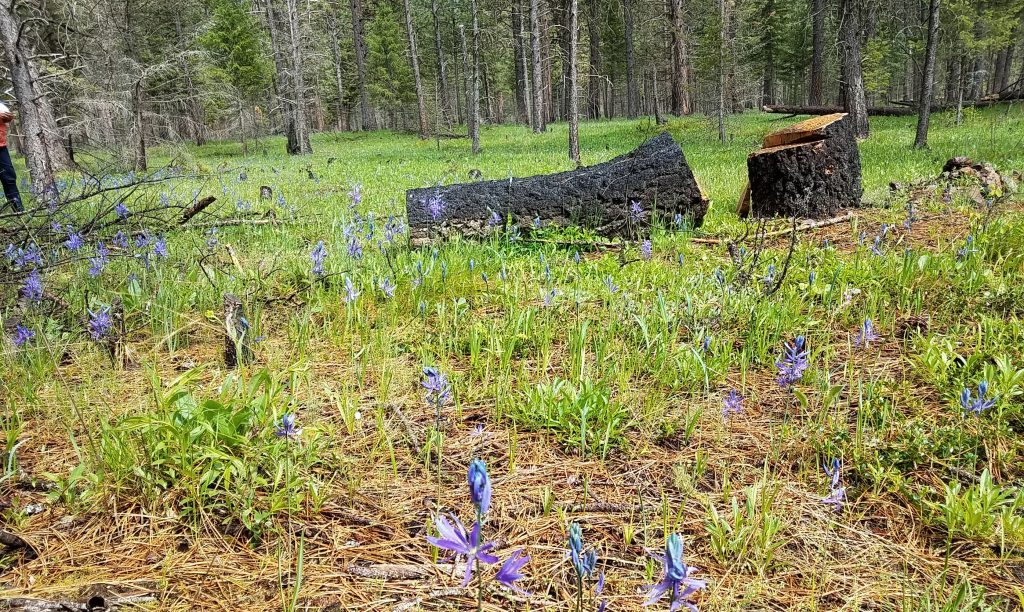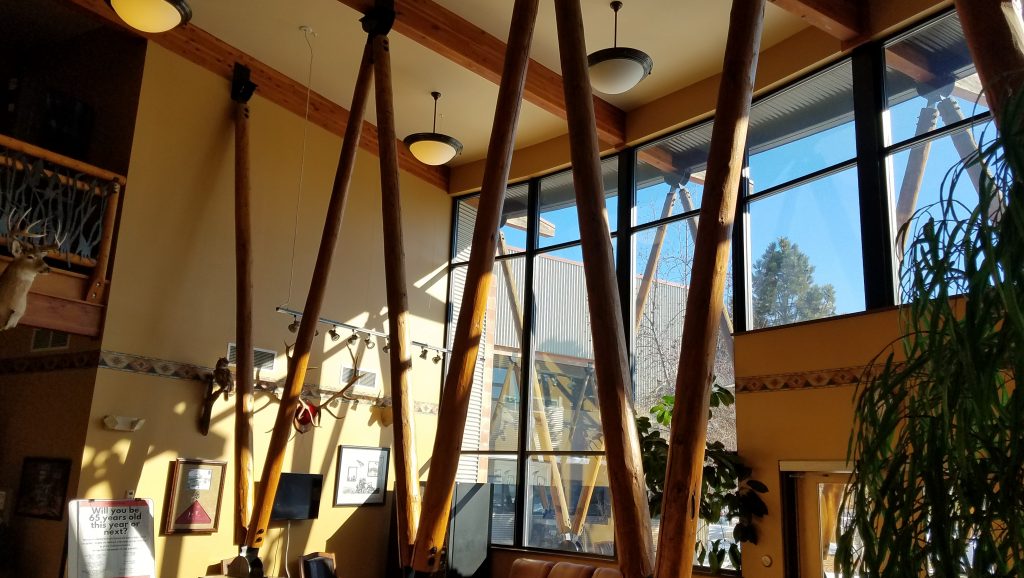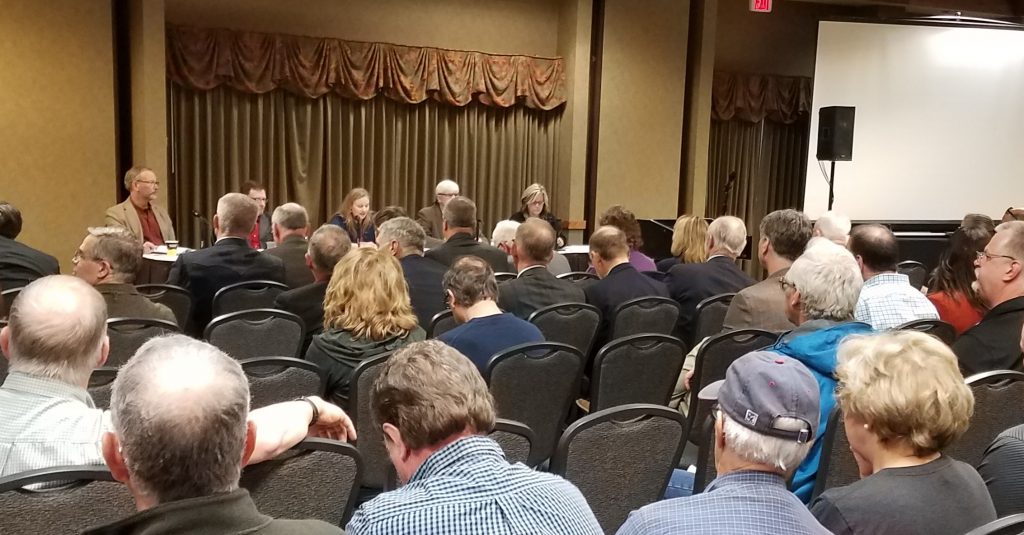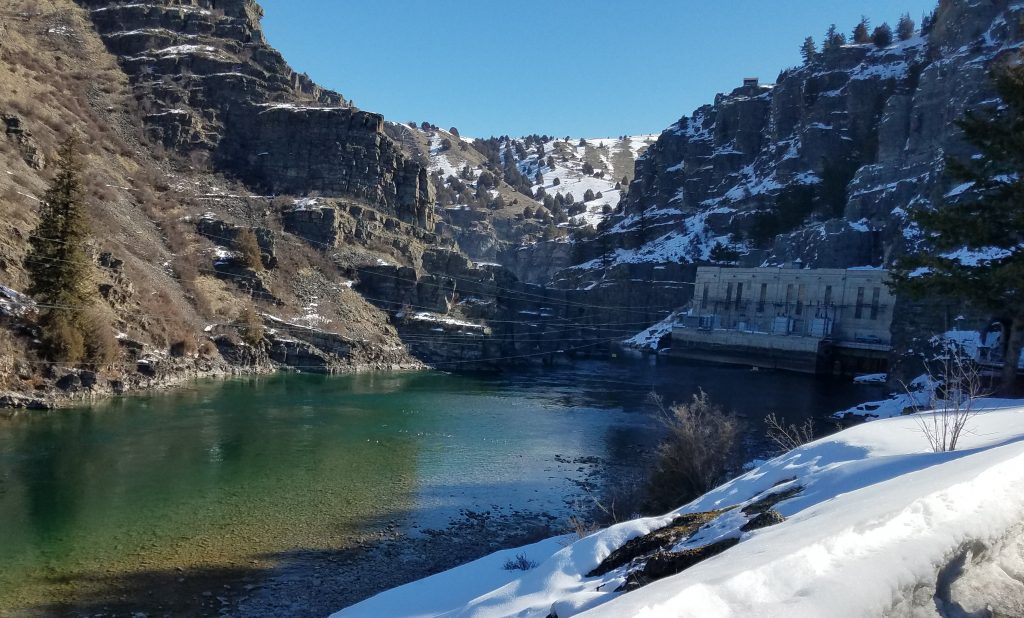Land empty of people is sad and incomplete – A land full of people who overreach and destroy nature is a horror. A land empty of people is sad and incomplete. Walking gently on the earth is essential, but that implies humans are indeed walking there. Harmony, not exclusion, is the valuable and achievable goal. Humans living in harmony with nature is joyful and helps us find meaning in life.
The picture on left shows camas, a native plant with edible roots once very common in moist meadows of the Pacific Northwest. It was an important part of Native American diets and still has great cultural significance. Natives Americans maintained these plant by regularly burning under the ponderosa pine. When fire was excluded, the brush filled forests almost eradicated camas. When prescribed fire brought regular light fires back, the camas came back too.
I was in Kalispell, Montana as part of my part-time (WAE) work for State Department. While I did nothing secret, it would be bad form to post on most of the discussions.
But I did have a talk with Confederated Salish and Kootenai Tribes (CSKT) foresters who met with me not as a State Department official but as a guy just interested in their land ethic and how they managed their forest land. I have been reading and listening to land ethic practitioners for years now, trying to develop a land ethic I can use and share. Of course, it is always a work in progress. Land ethics are written on the land we steward and that is in a perpetual state of becoming.
I wrote some notes and I think they are worth sharing.
Tribal forestry
My plane was leaving a little later in the day, and a couple of tribal foresters were kind enough to explain some of their forest land ethic to me. Well … they admitted that – like most people who work in the woods – they were delighted to talk trees anytime anybody was willing to listen, regretting only that we did not have time to go into the woods together.
They became even more eager when I told them that I had been in the reservation forests a year earlier to study tribal fire practices and admired their superb work with ponderosa pine regeneration. White bark pine has become a challenge because of beetle kill and warmer winters. Besides pine, tribal foresters work with fir, spruce, hemlock and tamarack, as well as understory and herb layers of the forest. Forests are more than just the trees. Unfortunately, timber cutting and fire exclusion in the last century had harmed the health of their forests, making them more susceptible to beetle infestations and disastrous fires. More holistic based forest management will help restore forest health, but this will take years, and, in most ways, it is a never-ending endeavor, as change is constant, which means what we do must adapt.
Land ethic for seven generations
They told me that their land ethic involved managing the forests to the benefit of seven generations of their people and in it general form it resembles the Aldo Leopold inspired land ethic I learned as a young man. Today we might call it adaptive management. It recognizes the complexity of the ecosystem and that we can never know enough to make final decisions. Rather we observe, act, reflect and act again based on the new information and we do this forever. There are not problems to be solved but conditions to be adapted. We agreed that land ethics cannot really be written down, but rather must be lived on the land.
Land empty of people is sad and incomplete
An important factor is their land ethic involved the people integrated into the system. This is much in line with conservationist thinking but is out of step with some preservationist ideals that seek to separate nature from almost all, or in more radical formulations all, human activity. A land where people overreach and destroy natures is obviously bad. But a land empty of people is also sad and undesirable. It is essential to walk gently on the earth, but that implies that humans are indeed walking there. Harmony, not exclusion, is a valuable and achievable goal, and humans living in harmony with nature is joyful.
Thin and burn
This beautiful ponderosa pine forest in the photo is not natural. It is maintained by regular use of fire. Tribal foresters are using a variety of tools, such as thinning and prescribed fire, to restore and maintain the health of their heritage forests. Their plan is to restore the mosaic patterns of open land and forests of various ages. They want to have five age classes of trees, ranging from the new forests to one with very old trees. They understand the different fire and cutting regimes. A ponderosa forest requires regular light fire. A lodgepole pine forest might need stand altering fire or harvest, while spruce and fir burn or are cleared much more rarely.
We spoke most about the ponderosa, since that is most common and requiring fire and thinning. They talked about work they had done with their own forests and trees on the adjoining National Forests. It is part of a good neighbor policy of the Forest Service. They thinned and burned all but a few acres, when a wildfire went through. It passed under the managed forests without causing significant loss, but when the fire got to the overstocked unmanaged forests, it got into the crowns and burned that forest to the ground. The fire got so hot that it sterilized the soils, setting regeneration back decades.
THIS is an unnatural fire.
A land ethic for the generations
The foresters talked a little about tribal history. The Salish and Kootenai are mountain people and their diets consisted of game that could be hunted in the mountains and plants gathered there. This contrasts with some tribes that lived along the rivers and subsisted on salmon. Some of these people were related and trade was brisk, so it was not a straight boundary. The people also hunted bison. They were mobile and left the higher mountains in the fall, to return in the spring. On leaving their mountain camps, they set fire to the woods. These fires burned naturally, most going out soon after, but some persisting until quenched by winter snows. This is what helped produce the open woods and the mosaic pattern. (People unfamiliar with fire in the woods have the impression that a fire goes through evenly, burning everything in the path. This is not how it works. Vagaries in vegetation type, soil moisture, wind direction and just plan random chance mean the fire creates essentially an archipelago of different and diverse patches.)
The practice of setting winter fires mostly stopped when reservation life made seasonal migrations more difficult or impossible and when, during the early and mid-20th Century the expert opinion was that fire was an enemy to be fought and defeated. Prescribed fires today are less extensive but designed to recreate the diverse and varied archipelago environments.
This is not the first time I have been in these forests. Attached in my note from a fire conference last year.
I have included some pictures from the trips. The first two are just scenes.
Picture #3 is from the Seli’š Ksanka Qlispe-Dam, formerly known as Kerr Dam, owned by CSKT tribes since 2015 and managed by Energy Keepers, a tribal firm. It is the first example of a Native American nation in the United States owning a hydroelectric dam. CSKT also operates the local electricity provider, Mission Valley Power.
It is a concrete gravity-arch dam, built in 1938. The dam was designed to generate hydroelectricity but also serves recreational and irrigation uses. We were able to visit the dam powerhouse on the second day of the visit, but snow made it impossible to see the panoramic views of the dam and the lake.
Picture # 4 is a war memorial outside the CSKT tribal headquarters, produced by a local artist. Members of the CSKT have served in honorably and in significant numbers in our nation’s armed forces.
Picture # 5 is from the public town hall meeting in Kalispell.





